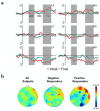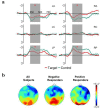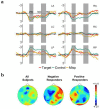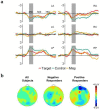Consonant and Vowel Processing in Word Form Segmentation: An Infant ERP Study
- PMID: 29385046
- PMCID: PMC5836043
- DOI: 10.3390/brainsci8020024
Consonant and Vowel Processing in Word Form Segmentation: An Infant ERP Study
Abstract
Segmentation skill and the preferential processing of consonants (C-bias) develop during the second half of the first year of life and it has been proposed that these facilitate language acquisition. We used Event-related brain potentials (ERPs) to investigate the neural bases of early word form segmentation, and of the early processing of onset consonants, medial vowels, and coda consonants, exploring how differences in these early skills might be related to later language outcomes. Our results with French-learning eight-month-old infants primarily support previous studies that found that the word familiarity effect in segmentation is developing from a positive to a negative polarity at this age. Although as a group infants exhibited an anterior-localized negative effect, inspection of individual results revealed that a majority of infants showed a negative-going response (Negative Responders), while a minority showed a positive-going response (Positive Responders). Furthermore, all infants demonstrated sensitivity to onset consonant mispronunciations, while Negative Responders demonstrated a lack of sensitivity to vowel mispronunciations, a developmental pattern similar to previous literature. Responses to coda consonant mispronunciations revealed neither sensitivity nor lack of sensitivity. We found that infants showing a more mature, negative response to newly segmented words compared to control words (evaluating segmentation skill) and mispronunciations (evaluating phonological processing) at test also had greater growth in word production over the second year of life than infants showing a more positive response. These results establish a relationship between early segmentation skills and phonological processing (not modulated by the type of mispronunciation) and later lexical skills.
Keywords: Event-related brain potentials (ERPs); French-learning infants; consonant bias; individual variability; lexical processing; word form segmentation.
Conflict of interest statement
The authors declare no conflict of interest.
Figures








Similar articles
-
Vowels, then consonants: Early bias switch in recognizing segmented word forms.Cognition. 2016 Oct;155:188-203. doi: 10.1016/j.cognition.2016.07.003. Epub 2016 Jul 16. Cognition. 2016. PMID: 27428809
-
Consonant/vowel asymmetry in early word form recognition.J Exp Child Psychol. 2015 Mar;131:135-48. doi: 10.1016/j.jecp.2014.11.011. Epub 2014 Dec 26. J Exp Child Psychol. 2015. PMID: 25544396
-
Danish 20-month-olds' recognition of familiar words with and without consonant and vowel mispronunciations.Phonetica. 2023 Aug 3;80(5):309-328. doi: 10.1515/phon-2023-2001. Print 2023 Oct 26. Phonetica. 2023. PMID: 37533184
-
Vowels and consonants matter equally to British English-learning 11-month-olds' familiar word form recognition.J Child Lang. 2024 Sep;51(5):1085-1108. doi: 10.1017/S0305000923000223. Epub 2023 Jun 13. J Child Lang. 2024. PMID: 37309654
-
Call me Alix, not Elix: vowels are more important than consonants in own-name recognition at 5 months.Dev Sci. 2015 Jul;18(4):587-98. doi: 10.1111/desc.12242. Epub 2014 Oct 7. Dev Sci. 2015. PMID: 25294431
Cited by
-
Infants Segment Words from Songs-An EEG Study.Brain Sci. 2020 Jan 9;10(1):39. doi: 10.3390/brainsci10010039. Brain Sci. 2020. PMID: 31936586 Free PMC article.
-
Infants' discrimination of consonant contrasts in the presence and absence of talker variability.Infancy. 2021 Jan;26(1):84-103. doi: 10.1111/infa.12371. Epub 2020 Oct 16. Infancy. 2021. PMID: 33063948 Free PMC article.
-
Early recognition of familiar word-forms as a function of production skills.Front Psychol. 2022 Sep 16;13:947245. doi: 10.3389/fpsyg.2022.947245. eCollection 2022. Front Psychol. 2022. PMID: 36186391 Free PMC article.
-
Probing the Impact of Prematurity on Segmentation Abilities in the Context of Bilingualism.Brain Sci. 2023 Mar 28;13(4):568. doi: 10.3390/brainsci13040568. Brain Sci. 2023. PMID: 37190533 Free PMC article.
References
Grants and funding
LinkOut - more resources
Full Text Sources
Other Literature Sources

